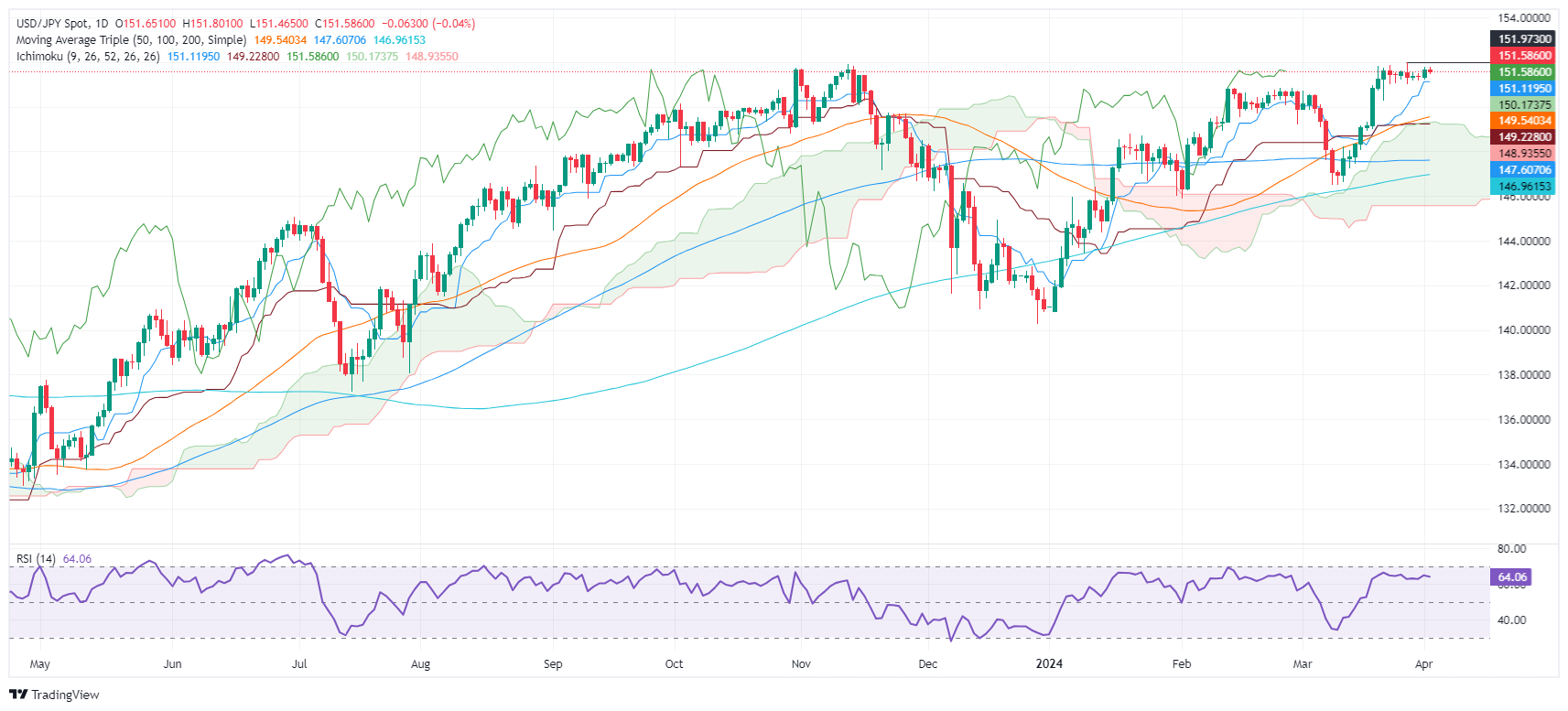- The USD/JPY is trading lower due to the possible intervention of the Japanese authorities.
- Technical analysis shows 152.00 as a crucial hurdle; Overcoming it could target the 153.00 level for buyers.
- A break below the Tenkan-Sen could lead to losses below 150.00, with the Ichimoku Cloud providing additional key points for traders.
USD/JPY remained limited around 151.50 on Tuesday amid threats of intervention by Japanese authorities. The close correlation between the 10-year US Treasury yield and majors has not influenced the pair's price action, which has remained below the 152.00 mark.
USD/JPY Price Analysis: Technical Outlook
The USD/JPY pair remains limited by the 152.00 mark, although technical support is found in the Tenkan-Sen at 151.12. If buyers recapture 152.00, that will pave the way to rest the 153.00 figure. On the other hand, if the sellers push the exchange rate below the Tenkan Sen, that will pave the way towards 151.00.
Once overcome, next support emerges at the Senkou Span A at 150.17, followed by the Kijun-Sen at 149.23. Further weakness in the pair could send it towards the Senkou Span B at 148.93, well inside the Ichimoku (Kumo) cloud.
USD/JPY Price Action – Daily Chart

Frequently Asked Questions about the Japanese Yen
What factors determine the price of the Japanese Yen?
The Japanese Yen (JPY) is one of the most traded currencies in the world. Its value is determined broadly by the performance of the Japanese economy, but more specifically by the policy of the Bank of Japan, the differential between the yields of Japanese and US bonds or the risk sentiment among traders, among other factors.
How do decisions by the Bank of Japan affect the Japanese Yen?
One of the mandates of the Bank of Japan is currency control, so its movements are key for the Yen. The BoJ has intervened directly in currency markets on occasion, usually to lower the value of the Yen, although it often refrains from doing so due to the political concerns of its major trading partners. The BoJ's current ultra-loose monetary policy, based on massive stimulus to the economy, has caused the depreciation of the Yen against its main currency pairs. This process has been exacerbated more recently by a growing policy divergence between the Bank of Japan and other major central banks, which have opted to sharply raise interest rates to combat decades-old levels of inflation.
How does the spread between Japanese bond yields and US bond yields affect the Japanese Yen?
The Bank of Japan's ultra-loose monetary policy stance has led to increased policy divergence with other central banks, particularly the US Federal Reserve. This favors the widening of the spread between US and Japanese 10-year bonds, which favors the Dollar against the Yen.
How does general risk sentiment influence the Japanese Yen?
The Japanese Yen is often considered a safe haven investment. This means that in times of market stress, investors are more likely to put their money in the Japanese currency due to its supposed reliability and stability. In turbulent times, the Yen is likely to appreciate against other currencies that are considered riskier to invest in.
Source: Fx Street
I am Joshua Winder, a senior-level journalist and editor at World Stock Market. I specialize in covering news related to the stock market and economic trends. With more than 8 years of experience in this field, I have become an expert in financial reporting.







